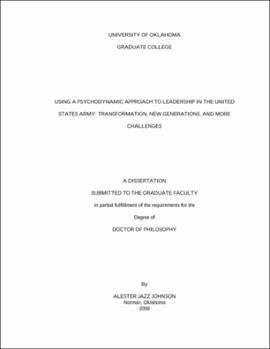| dc.contributor.advisor | Terry, Robert A | |
| dc.creator | Johnson, Alester Jazz | |
| dc.date.accessioned | 2019-04-27T21:27:41Z | |
| dc.date.available | 2019-04-27T21:27:41Z | |
| dc.date.issued | 2008 | |
| dc.identifier | 99211044302042 | |
| dc.identifier.uri | https://hdl.handle.net/11244/318742 | |
| dc.description.abstract | The US Army is a diverse and rapidly changing organization made up of people from different groups, ethnicities, and geographies. This increases the possibility for relationship uncertainties between the leader and their subordinates. This research is not intended to criticize the Army institution or its' leadership methodologies in any manner. Rather it provides a perspective that may be relevant when viewed in terms of maintaining the "All Volunteer Army" and in the context of the title of this research, "Transformation, New Generations, and More Challenges." The central research objective addressed in this research investigated the extent to which using a Psychodynamic Approach to Leadership (PAL) would influence the relationship between leaders and their subordinates. In this research, an attempt was made to determine whether using a Psychodynamic Approach to Leadership (PAL) could foster a better relationship and understanding between leader and subordinates, subsequently creating a positive environment in which the relationship may develop, while also increasing job satisfaction, job performance, personal self-awareness, trust in others, and reinforcing Army values. The purpose then is to connect people through psychodynamics training and awareness while fostering a better understanding of their conscious and unconscious motives and activities. | |
| dc.description.abstract | A survey assessment instrument was developed which introduced the concept of psychodynamics theory while also collecting a measure of baseline personality. Administration of the surveys included military leaders and subordinate Soldiers, and civilian leaders and subordinate civilians serving at various levels within Army organizations. All questionnaires were Likert-based. Although the initial study period was designed to be between three and six months, subsequent time constraints, an unexpected US Army transformation in the work environment, and the rapid gearing up of soldiers for deployment to Iraq, Afghanistan, and other world-wide missions resulted in the study being conducted for a period of one month. At the conclusion of the experiment and analyzation of the data, a positive correlation was yielded suggesting that implementation of a Psychodynamic Approach to Leadership may be beneficial to the Army and the individual. | |
| dc.format.extent | 128 pages | |
| dc.format.medium | application.pdf | |
| dc.language | en_US | |
| dc.relation.requires | Adobe Acrobat Reader | |
| dc.subject | Leadership | |
| dc.subject | Command of troops | |
| dc.subject | Psychodynamic psychotherapy | |
| dc.title | Using A Psychodynamic Approach to Leadership in the United States Army | |
| dc.type | text | |
| dc.type | document | |
| dc.thesis.degree | Ph.D. | |
| ou.group | Jeannine Rainbolt College of Education::Department of Educational Psychology | |
